Alfred Augustus Glendening Jr. stands as a notable figure among the British painters of the late Victorian and early Edwardian eras. Active during a period of immense social and industrial change, his work often harked back to an idealized vision of rural England, capturing serene landscapes and gentle human figures within them. His art provides a window into the popular tastes and nostalgic sentiments of his time, offering a counterpoint to the burgeoning modernist movements that would soon reshape the artistic landscape.
Early Life and Artistic Lineage
Born in 1861, Alfred Augustus Glendening Jr. was seemingly destined for a life in the arts. He was the son of Alfred Augustus Glendening Sr. (circa 1840–c.1910/1921, dates vary across sources), a respected and prolific landscape painter in his own right. The elder Glendening was known for his picturesque views of the British countryside, particularly river scenes and landscapes of Scotland, Wales, and England. It is highly probable that Glendening Jr. received his initial artistic training from his father, absorbing the techniques and thematic preoccupations that characterized Victorian landscape and genre painting.
Growing up in this artistic environment would have provided the young Glendening with invaluable exposure to the practicalities of a painter's life, from studio practice to the importance of exhibiting and securing patronage. The Victorian art world was a vibrant, competitive sphere, and a familial connection to an established artist would have been a significant advantage.
Artistic Style and Thematic Focus
Glendening Jr.'s oeuvre primarily consists of landscape paintings, often populated with figures, and specific genre scenes that celebrate the rustic charm of country life. His style is characterized by a meticulous attention to detail, a soft, harmonious palette, and a gentle, almost sentimental, rendering of his subjects. He worked proficiently in both oils and watercolors, demonstrating a fine command of both mediums.
The Allure of the Landscape
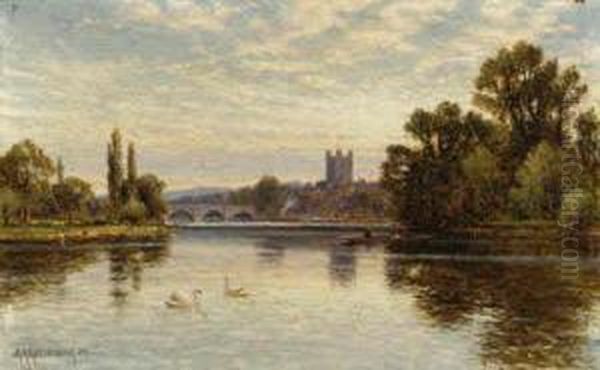
Like his father, Glendening Jr. was drawn to the natural beauty of the British Isles. His landscapes often feature tranquil rivers, lush meadows, ancient woodlands, and picturesque country lanes. Works such as "Henley on the Thames" (an oil painting) exemplify his skill in capturing the specific atmosphere of a location, with careful observation of light, water, and foliage. The Thames, a recurring subject for many British artists from J.M.W. Turner and John Constable in earlier generations to contemporaries like James Tissot (who painted scenes of social life on the Thames), offered a rich source of inspiration. Glendening Jr.'s interpretations tend towards the serene and idyllic, emphasizing the recreational and picturesque qualities of the river.
His landscapes are rarely empty; they often serve as a backdrop for human activity or imply a human presence, aligning with the Victorian appreciation for narrative and sentiment within art. This approach differed from the more purely atmospheric or scientifically observed landscapes of some earlier or contemporary movements.
Figures in the Landscape: The Idealized Rural Woman
A significant portion of Glendening Jr.'s work focuses on figures, particularly women, within these pastoral settings. These are not typically portraits of specific individuals but rather idealized representations of rural femininity. His female figures are often depicted engaged in gentle activities: gathering flowers, resting by a stream, walking along a country path, or, as in the watercolor "Maid by a Fountain" (1898), pausing in a moment of quiet contemplation.
These women are usually dressed in somewhat timeless, rustic attire, often with bonnets or hats, their expressions serene and their demeanor graceful. Works like "A Leisurely Moment" (a drawing and watercolor combination) capture this characteristic. This thematic choice resonated with a Victorian audience that often romanticized rural life as a pure, unspoiled alternative to the rapidly industrializing cities. Artists like Myles Birket Foster and Helen Allingham, celebrated for their charming watercolor depictions of cottages, gardens, and country folk, catered to a similar sensibility, and Glendening Jr.'s work can be seen as part of this broader tradition.
The depiction of women in his art aligns with certain Victorian ideals of femininity – gentle, connected to nature, and embodying a sense of domestic tranquility. While some artists of the period, like Luke Fildes or Hubert von Herkomer, explored the harsher realities of rural poverty or urban life (social realism), Glendening Jr. generally presented a more comforting and aspirational vision.
Technique and Mediums
Glendening Jr. was adept in both oil painting and watercolor. His oil paintings exhibit a smooth finish and careful blending, typical of academic practice of the time, allowing for detailed rendering of textures in foliage, water, and costume. His use of color is generally naturalistic, often imbued with a soft, warm light that enhances the idyllic mood.
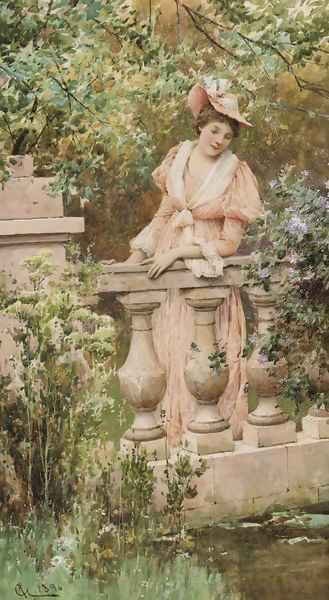
His watercolors, such as "Maid by a Fountain," demonstrate a lighter touch, with translucent washes and delicate linework. Watercolor painting enjoyed immense popularity in Victorian Britain, with artists like the aforementioned Myles Birket Foster and Helen Allingham, as well as figures like David Cox and Peter De Wint from earlier in the century, elevating its status. Glendening Jr.'s proficiency in this medium allowed him to capture the fleeting effects of light and atmosphere with immediacy and charm.
Influences and Contemporaries
Alfred Glendening Jr.'s art was undoubtedly shaped by several influences. The most direct would have been his father, Alfred Glendening Sr., whose landscape style provided a foundational model. Beyond this familial connection, his work sits within the broader currents of late Victorian art.
The enduring legacy of the Pre-Raphaelite Brotherhood, with its emphasis on truth to nature, detailed observation, and often sentimental or literary themes, can be seen as a distant echo in the meticulousness of Glendening Jr.'s work, though he did not share their more radical stylistic or thematic concerns. Artists like John Everett Millais, in his later, more popular phase, produced landscapes and genre scenes that appealed to similar Victorian tastes.
More directly, Glendening Jr. was a contemporary of numerous artists who specialized in landscape and genre painting. Figures like Benjamin Williams Leader were immensely popular for their expansive and often dramatic landscapes of England, Scotland, and Wales. The work of the Williams family of painters, including Sidney Richard Percy, also focused on detailed and picturesque British scenery and found a ready market.
In terms of figurative genre painting with a rural theme, artists like George Clausen and Henry Herbert La Thangue, associated with the Newlyn School and British Impressionism, were also depicting country life. However, their approach was often more naturalistic, influenced by French Realism and Impressionism, and sometimes carried a stronger social commentary or a more robust, less idealized portrayal of rural labor than Glendening Jr.'s gentler visions. Other contemporaries who painted charming genre scenes included Marcus Stone and Yeend King.
The market for art during Glendening Jr.'s lifetime was robust, with institutions like the Royal Academy of Arts, the Royal Society of British Artists (RBA), and the Royal Institute of Painters in Water Colours (RI) holding major annual exhibitions. It is documented that Glendening Jr. exhibited his works at such prestigious venues, including the Royal Academy, the RBA, and the Royal Institute of Oil Painters (ROI), which was crucial for an artist's reputation and sales.
Notable Works and Their Characteristics
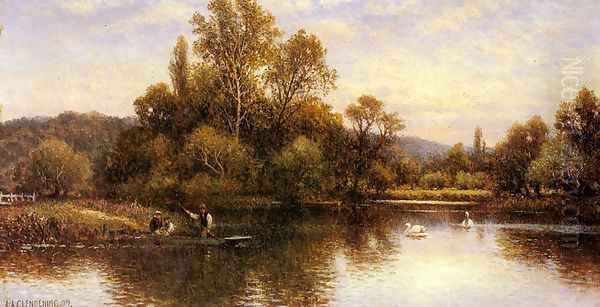
While a comprehensive catalogue raisonné of Alfred Glendening Jr.'s work is not readily available, several pieces highlight his characteristic style and themes:
"Henley on the Thames": This oil painting likely depicts a scene along the famous rowing course, a popular subject for artists. It would showcase his ability to render water, boats, and the lush riverbanks of the Thames Valley, a region frequently painted by artists like George Vicat Cole.
"A Leisurely Moment": This title suggests a typical genre scene, likely featuring one or more figures, probably female, enjoying a peaceful interlude in a natural setting. The combination of drawing and watercolor indicates a work that might possess both the precision of line and the softness of color washes.
"Maid by a Fountain" (1898): This watercolor, specifically dated, points to his continued production of idealized female figures in rustic or garden settings. The fountain motif adds a touch of classical or romantic charm.
Other typical titles found in auction records and art databases include scenes of harvesting, country courtship, figures by streams or cottages, and views in Surrey, Sussex, and along the Thames. These titles reinforce his focus on the picturesque and the sentimental aspects of rural England. For instance, works titled "Gathering Wildflowers" or "A Country Lane" are common for artists of his ilk.
His paintings often feature a strong narrative element, even if subtle. The viewer is invited to imagine the thoughts or circumstances of the figures depicted, contributing to the sentimental appeal of his art.
The Question of Collaborators
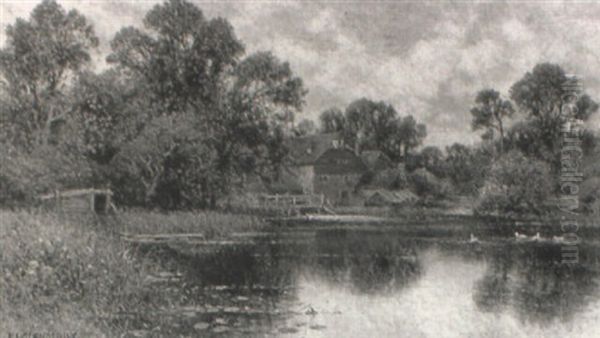
The provided initial information mentioned D. Feller, M. Thompson, and F. Weinhold as potential collaborators. In the context of a Victorian painter like Glendening Jr., direct collaboration on a single canvas in the way modern artists might collaborate was less common, though not unheard of (e.g., landscape painters sometimes had other artists add figures or animals). However, these names do not readily appear as known artistic collaborators of Glendening Jr. in standard art historical records. It's possible these names relate to printmakers who might have created reproductions of his work, or there might be a misunderstanding in the source data, perhaps confusing him with another individual or a different field of activity. Without further specific evidence linking these individuals to his artistic production, it is difficult to elaborate on such collaborations within his painting career.
Social Activities and Public Image
For many Victorian artists, their public image was cultivated through their exhibited works, their participation in artistic societies, and their interactions within art circles. The provided information, however, seems to conflate Alfred Glendening Jr., the artist, with Parris N. Glendening, a modern American politician known for environmental policies. This is a clear case of mistaken identity.
Alfred Glendening Jr., the British painter (1861-1907), would not have been involved in 20th or 21st-century American environmental policy. His "social activities" would have revolved around the art world of his time: exhibitions, art societies, and perhaps teaching. His "public image" would have been that of a painter of charming and accessible scenes, appealing to the tastes of the middle and upper classes who purchased such art. There is no historical record of him being a prominent public figure outside of his artistic contributions.
Artistic Achievements and Historical Evaluation
Alfred Augustus Glendening Jr.'s primary artistic achievement lies in his consistent and skilled production of paintings that captured a particular Victorian ideal of rural England. He was a competent craftsman who understood the market for his work and catered to it effectively. His paintings are characterized by their pleasant compositions, agreeable color schemes, and sentimental appeal.
In the broader sweep of art history, Glendening Jr. is considered a secondary figure when compared to the great innovators of his time or the towering figures of British art like Turner or Constable. He was not a revolutionary; rather, he worked within established conventions, refining a popular style. However, his work holds value for several reasons:
1. Social Document: His paintings reflect the tastes, values, and escapist desires of a segment of Victorian society. They tell us what kind of imagery was popular and why.
2. Artistic Skill: While not groundbreaking, his works demonstrate a proficient level of technical skill in both oil and watercolor.
3. Contribution to Genre: He contributed to the enduring genre of British landscape and rustic figurative painting, a tradition with deep roots.
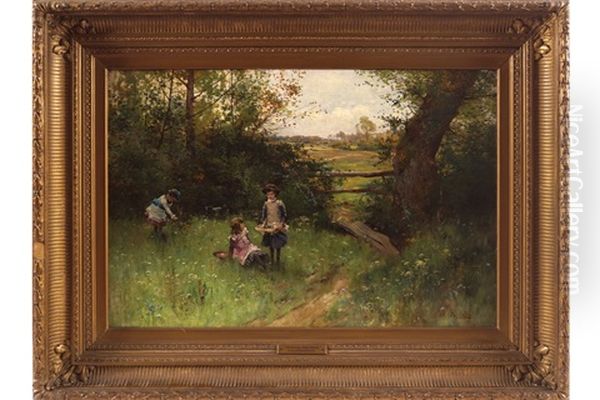
4. Market Presence: The continued appearance of his works in art auctions indicates an ongoing, albeit modest, appreciation among collectors who value traditional British painting. A watercolor like "Maid by a Fountain" fetching £120-£180 (as noted in the provided information, likely from an older auction record) reflects this niche market. Prices for his oils, particularly larger and more detailed examples, can be significantly higher.
His art can be compared to that of contemporaries like Frederick Morgan or Arthur John Elsley, who also specialized in sentimental genre scenes, often featuring children and animals, which were enormously popular. While Glendening Jr.'s focus was more on adult figures and landscapes, the underlying appeal to sentiment and idealized domesticity is similar.
Legacy and Conclusion
Alfred Augustus Glendening Jr. passed away in 1907, just as the art world was on the cusp of radical transformations with the rise of Fauvism, Cubism, and other avant-garde movements. His art, deeply rooted in 19th-century sensibilities, might have seemed increasingly old-fashioned to progressive critics even during his later years.
Today, his work is appreciated by those who enjoy traditional British landscape and genre painting. His paintings evoke a sense of nostalgia for a bygone era, a seemingly simpler and more harmonious vision of England. While he may not have reshaped the course of art history, Alfred Glendening Jr. successfully created a body of work that pleased his contemporaries and continues to find an audience. He remains a fine representative of a particular strand of late Victorian art that valued beauty, sentiment, and the picturesque charm of the British countryside, standing alongside artists like Heywood Hardy who also excelled in capturing rural life and sporting scenes with a similar appeal to traditional tastes. His paintings serve as gentle reminders of a world idealized through the artist's sympathetic eye.